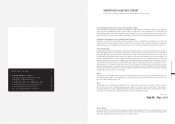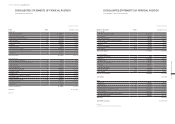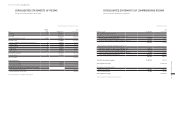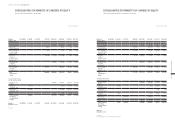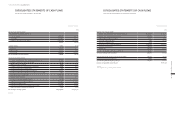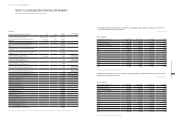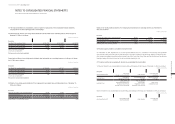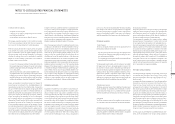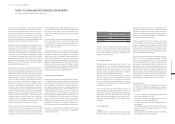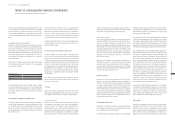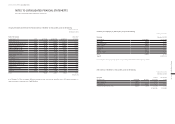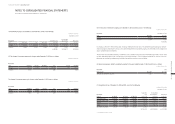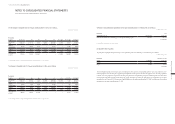Hyundai 2014 Annual Report Download - page 49
Download and view the complete annual report
Please find page 49 of the 2014 Hyundai annual report below. You can navigate through the pages in the report by either clicking on the pages listed below, or by using the keyword search tool below to find specific information within the annual report.
HYUNDAI MOTOR COMPANY Annual Report 2014
FINANCIAL STATEMENTS / 9796
NOTES TO CONSOLIDATED FINANCIAL STATEMENTS
AS OF AND FOR THE YEARS ENDED DECEMBER 31, 2014 AND 2013
is achieved when the Company:
■ has power over the investee;
■ is exposed, or has rights, to variable returns from its involve-
ment with the investee; and
■ has the ability to use its power to affect its returns.
The Company reassesses whether or not it controls an investee
if facts and circumstances indicate that there are changes to
one or more of the three elements of control listed above.
When the Company has less than a majority of the voting rights
of an investee, it has power over the investee when the voting
rights are sufficient to give it the practical ability to direct the
relevant activities of the investee unilaterally. The Company
considers all relevant facts and circumstances in assessing
whether or not the Company’s voting rights in an investee are
sufficient to give it power, including:
■ the size of the Company’s holding of voting rights relative to
the size and dispersion of holdings of the other vote holders;
■ potential voting rights held by the Company, other vote hold-
ers or other parties;
■ rights arising from other contractual arrangements; and
■ any additional facts and circumstances that indicate that the
Company has, or does not have, the current ability to direct the
relevant activities at the time that decisions need to be made,
including voting patterns at previous shareholders’ meetings.
Income and expenses of subsidiaries acquired or disposed of
during the period are included in the consolidated statement of
comprehensive income from the effective date of acquisition
and up to the effective date of disposal, as appropriate. When
necessary, adjustments are made to the financial statements of
subsidiaries to bring their accounting policies into line with those
used by the Company. All intra-group transactions, balances,
income and expenses are eliminated in full on consolidation.
Non-controlling interests are presented in the consolidated
statement of financial position within equity, separately from
the equity of the owners of the Company. The carrying amount
of non-controlling interests consists of the amount of those
non-controlling interests at the initial recognition and the chang-
es in shares of the non-controlling interests in equity since the
date of the acquisition. Total comprehensive income is attributed
to the owners of the Company and to the non-controlling inter-
ests even if the non-controlling interest has a deficit balance.
Changes in the Group’s ownership interests in subsidiaries, with-
out a loss of control, are accounted for as equity transactions.
The carrying amounts of the Group’s interests and the non-con-
trolling interests are adjusted to reflect the changes in their
relative interests in the subsidiaries. Any difference between the
amount by which the non-controlling interests are adjusted and
the fair value of the consideration paid or received is recognized
directly in equity and attributed to owners of the Group.
When the Group loses control of a subsidiary, the profit or loss
on disposal is calculated as the difference between (i) the ag-
gregate of the fair value of the consideration received and the
fair value of any retained interest and (ii) the previous carrying
amount of the assets (including goodwill), liabilities of the sub-
sidiary and any non-controlling interests. When assets of the
subsidiary are carried at revalued amounts or fair values and
the related cumulative gain or loss has been recognized in other
comprehensive income and accumulated in equity, the amounts
previously recognized in other comprehensive income and accu-
mulated in equity are accounted for as if the Group had directly
disposed of the relevant assets (i.e. reclassified to profit or loss
or transferred directly to retained earnings as specified by appli-
cable K-IFRSs). The fair value of any investment retained in the
former subsidiary at the date when control is lost is regarded as
the fair value on initial recognition for subsequent accounting
under K-IFRS 1039 ‘Financial Instruments: Recognition and Mea-
surement’ or, when applicable, the cost on initial recognition of
an investment in an associate or a jointly controlled entity.
(4) Business combination
Acquisitions of businesses are accounted for using the acquisi-
tion method. The consideration transferred in a business combi-
nation is measured at fair value, which is calculated as the sum
of the acquisition-date fair values of the assets transferred by
the Group, liabilities incurred by the Group to the former owners
of the acquiree and the equity interests issued by the Group in
exchange for control of the acquiree. The consideration includes
any asset or liability resulting from a contingent consideration
arrangement and is measured at fair value. Acquisition-related
costs are recognized in profit or loss as incurred. When a busi-
ness combination is achieved in stages, the Group’s previously
held equity interest in the acquiree is remeasured at its fair val-
ue at the acquisition date (i.e. the date when the Group obtains
control) and the resulting gain or loss, if any, is recognized in
profit or loss. Prior to the acquisition date, the amount resulting
from changes in the value of its equity interest in the acquiree
that have previously been recognized in other comprehensive
income are reclassified to profit or loss where such treatment
would be appropriate if that interest were directly disposed of.
(5) Revenue recognition
1) Sale of goods
The Group recognizes revenue from sale of goods when all of
the following conditions are satisfied:
■ the Group has transferred to the buyer the significant risks
and rewards of ownership of the goods; the amount of reve-
nue can be measured reliably;
■ it is probable that the economic benefits associated with the
transaction will flow to the Group
The Group grants award credits which the customers can redeem
for awards such as free or discounted goods or services. The
fair value of the award credits is estimated by considering the
fair value of the goods granted, the expected rate and period of
collection. The fair value of the consideration received or receiv-
able from the customer is allocated to award credits and sales
transaction. The consideration allocated to the award credits is
deferred and recognized as revenue when the award credits are
redeemed and the Group’s obligations have been fulfilled.
2) Rendering of services
The Group recognizes revenue from rendering of services based
on the percentage of completion when the amount of revenue
can be measured reliably and it is probable that the economic
benefits associated with the transaction will flow to the Group.
3) Royalties
The Group recognizes revenue from royalties on an accrual ba-
sis in accordance with the substance of the relevant agreement.
4) Dividend and interest income
Revenues arising from dividends are recognized when the right
to receive payment is established. Interest income is recognized
using the effective interest method as time passes.
5) Construction contracts
Where the outcome of a construction contract can be estimated
reliably, the contract revenue and contract costs associated with
the construction contract are recognized as revenue and ex-
penses, respectively by reference to the stage of completion of
the contract activity at the end of reporting period.
The percentage of completion of a contract activity is reliably
measured based on the proportion of contract costs incurred
for work performed to date relative to the estimated total con-
tract costs, by surveys of work performed or by completion of a
physical proportion of the contract work. Variations in contract
work, claim and incentive payments are included to the extent
that the amount can be measured reliably and its receipt is con-
sidered probable. Where the outcome of a construction contract
cannot be estimated reliably, contract revenue is recognized to
the extent of contract costs incurred that it is probable will be
recoverable. Contract costs are recognized as expenses in the
period in which they are incurred. When it is probable that total
contract costs will exceed total contract revenue, the expected
loss is recognized as an expense immediately.
(6) Foreign currency translation
The individual financial statements of each entity in the Group
are measured and presented in the currency of the primary
economic environment in which the entity operates (its func-
tional currency).
In preparing the financial statements of the individual entities,
transactions occurring in currencies other than their func-
tional currency (foreign currencies) are recorded using the
exchange rate on the dates of the transactions. At the end of
each reporting period, monetary items denominated in foreign
currencies are translated using the exchange rate at the report-
ing period. Non-monetary items that are measured in terms of
historical cost in a foreign currency are translated using the ex-
change rate at the date of the transaction. Non-monetary items
that are measured at fair value in a foreign currency are trans-
lated using the exchange rates at the date when the fair value
was determined. Exchange differences resulting from settlement
of assets or liabilities and translation of monetary items denom-
inated in foreign currencies are recognized in profit or loss in
the period in which they arise except for some exceptions.
For the purpose of presenting the consolidated financial state-
ments, assets and liabilities in the Group’s foreign operations


